Joan Littlewood’s Memos to Cedric Price
In this text, Ana Bonet Miró reflects on the memos written by Joan Littlewood addressed to her company of actors, and to Cedric Price during their collaboration on the Fun Palace project. For more on Littlewood and Price’s collaboration, listen to Ana Bonet Miró and Matthew Blunderfield in conversation for the Power and Public Space podcast, here.
In Joan Littlewood’s obituary in New Theatre Quarterly, former Theatre Workshop member and founding editor of the journal Clive Barker described the collection of notes she used to distribute among her company, always written in uppercase, before and after each performance as a ‘national treasure, a primary source on the art of the actor’. ‘She was eagle-eyed’, ‘and never missed a trick’. All the moments of lapsed concentration, loss of focus, generalisation instead of clarity, loss of objective, would be there in the next night’s notes. I once received a postcard from Orange in the south of France telling me she couldn’t hear one of my lines in the performance before she left England.’ [1] The article circulates one of her infamous notes related to the production of Mrs Wilson’s Diary in 1967, ‘COMPANY PLEASE NOTE’, where she instructs her company to ramp up the action that clownery requires:
‘(…) PLEASE PLAY ACTION. RHYTHM. AND THE “CRACKS” “WORDS” AS THROW AWAY… MERELY. AS PART OF THE STREAM – (NOT “MONUMENTS” AS NOW). DON’T BOTHER ABOUT WORD “WIT” LAUGHS. THIS CLOWNERIE SLOWS DOWN WHEN YOU DO SO – THE WHOLE “ENTERTAINMENT” IS BORING WHEN YOU “PLAY FOR LAUGHS” AS YOU ALL KNOW […].’ [2]
Similarly, during the production of Oh, What a Lovely War!, one of her notes complained about the company’s lack of flow and disregard for the audience during their performance the previous evening:
‘[…] ABOUT LAST NIGHT / THE BALANCE BETWEEN AUDIENCE & PIERROTS WAS WRONG ON RETIREMENT TO CHANGE AREA. VIC HIT A WEAK NOTE & YOU WERE ALL CHATTERING PRIVATELY IT SEEMED/ FANNY’S LAUGH RINGING OUT FROM OFFSTAGE WAS BAD – AN UNSHARED JOKE – YOU CAN’T LEAVE US OUT […] PROMENADE: MARY & MYE STILL SLOWER – DREAMIER ON ENTRANCE & NO STOPPING FEELING – THE MOVEMENT MUST FLOW. EVERYONE NEEDS THIS TECHNIQUE OF ENDLESS – GENTLE MOVEMENT IN THIS SCENE […]. [3]
For Littlewood, it was the precise control of movement and voice modulation that constructed the characters and led to flow on stage. These were techniques that Theatre Workshop mastered through rigorous training in the philosophy of movement developed by Hungarian choreographer Rudolf Laban through sessions led by his pupil and assistant Jean Newlove. Littlewood’s collaborator Murray Melvin has observed that what mattered to her, other than the script, was the truth conveyed through the physicality of each character. [4] And that truth of movement literally grew out of one’s feet – or else didn’t, as Littlewood acknowledged in one of her few recorded interviews: ‘The first thing I’d do would be to get people’s feet to work. Because, you know, I used to be under the stage clearing up, and you would think “that bastard” you could hear by his feet that they were diffident, or shuffling. Everything is in your feet, you know that’. [5] And so, such notes as ‘DARLING, YOU’VE GOT GREASEPAINT ON YOUR HEELS, GET OFF’ or ‘YOUR PERFORMANCE IS WONDERFUL BUT YOUR FEET ARE WAITING FOR A BUS’ would plaster the walls of the Theatre Royal (as remembered by the late actor Victor Spinetti). [6]
The production of the Fun Palace, the cultural project Littlewood developed with Cedric Price, was subject to similar critical scrutiny. Her traces criss-cross the archive of the project. ‘REF: HOW TO LIVE WITH 7’6”’, opens one of her notes associated with Camden Pilot development. (Figure 1) Sprinkled by comic silhouettes of body postures she complains about the lack of plurality in the action conveyed by the project’s audiences:
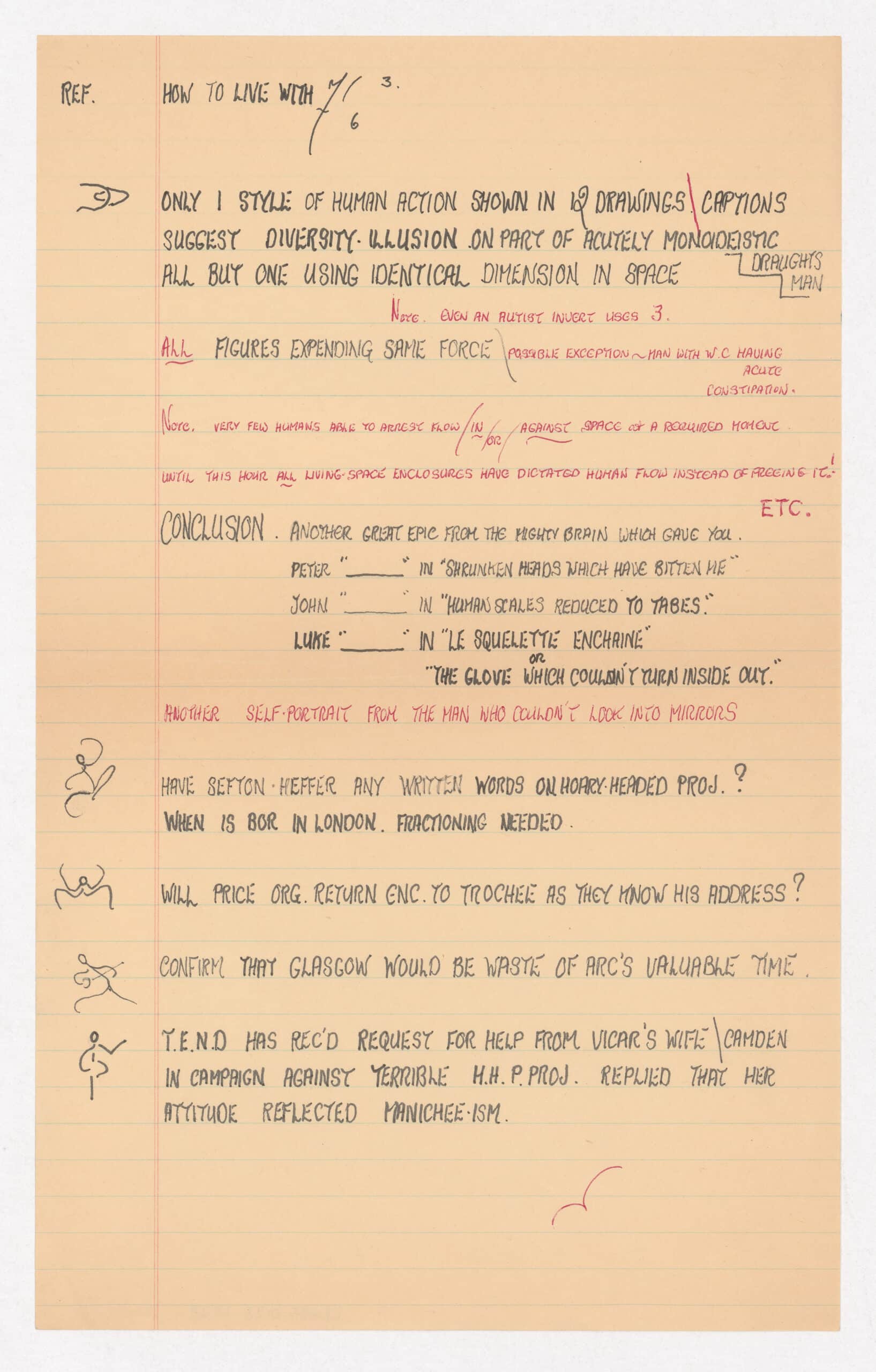
It is unusual to stumble upon such critical observations of Price’s work – at least by interlocutors other than Littlewood. Written in ruled yellow paper and unsigned, the note lay uncatalogued in the archive when I found it.
Occasions for celebration gave rise to other, less punitive messages to Price. For instance, Littlewood writes joyfully on the reverse page of the proof of the article ‘A Laboratory of Fun’ that was to be circulated in New Scientist in May 1964 (this was the first achievement of the Fun Palace’s active publicity strategy). Addressed ‘TO THE LANDLORD’ by his clown-tenant ‘TENT’, Littlewood – nicknamed ‘ISSY + MLLE MISERICORDIE’ – demands ‘MUSAK. MUSICA. AUDIO-DELICES. MOBILE KINEMA. KINETIC VICE SEWELLS’ to celebrate the publication’s preview – ‘THE VIEW’. [7] And she reclaims a celebratory drink, ‘ONE. PRICESON. NAMEDAY. BOISSON. OWED’. (Figure 2) The note encourages Price to disseminate his Potteries Thinkbelt project through the local press, in passing on a message from journalist and Fun Palace contributor Tom Driberg: ‘MR RAFFIA [ISRAEL]’: “THAT BOY MUST GET HIS PTB RAVES IN LOCAL POT-PRESS, TELL HIM”’. [8] She also acknowledges having received two personal communications from Price: ‘ACS RECEIPT OF 2 TWO II PERSONAL COM’CATS’. [9] The main role that publicity would play in the project seeps through the transparency of the note’s paper.
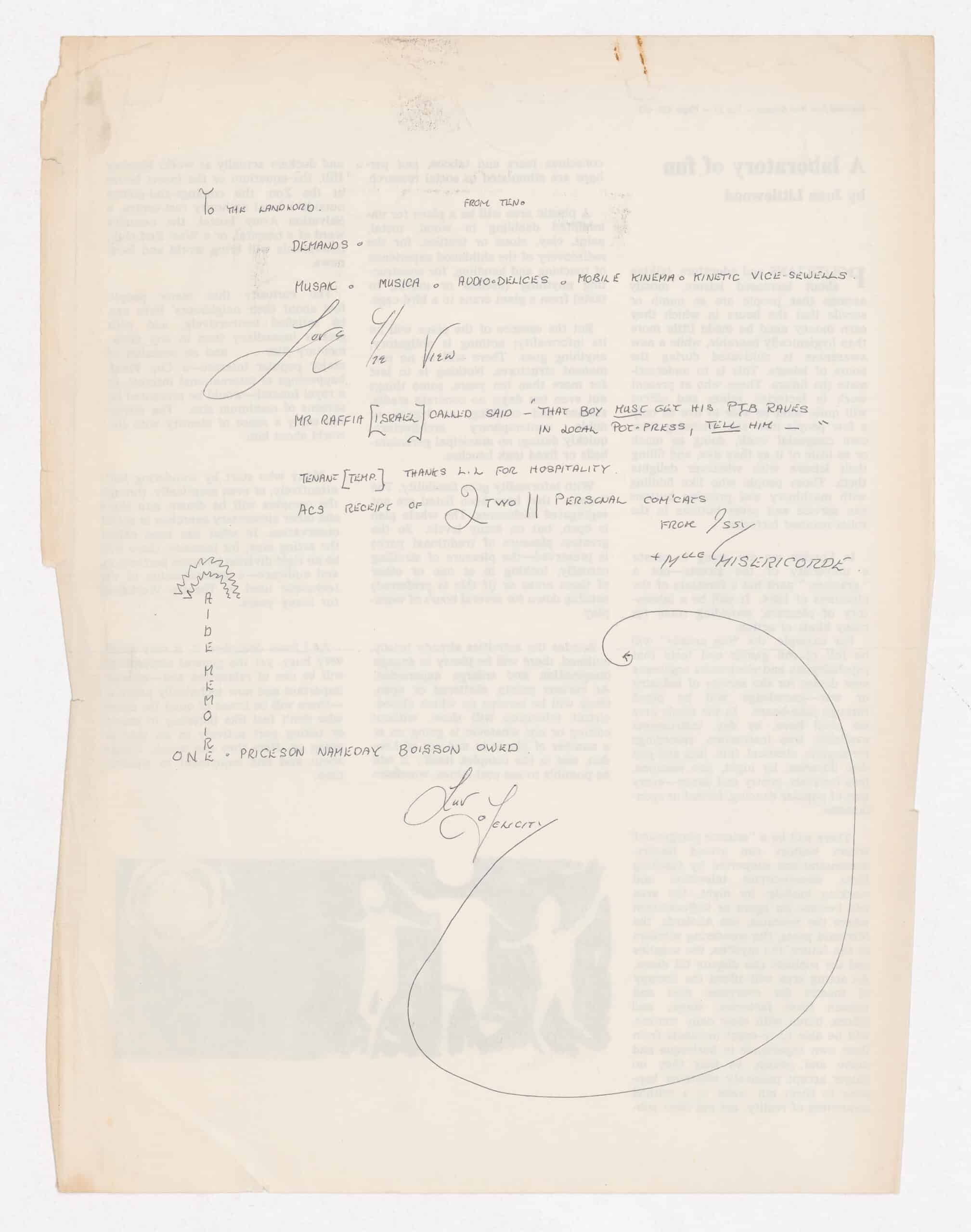
Littlewood appreciated the importance of publicity, but she also wearied of it. We see this years later, sometime in 1981, when she contacted Price to share her struggle to preserve the Theatre Royal amidst ongoing redevelopment plans in Stratford (this was after the passing of her partner and Theatre Workshop manager Gerry Raffles in 1975): ‘WORRIED THAT YOU MISSED THIS MASTERPIECE OF ARCHITECTURAL NECROPHILIA’ [10] – she noted on the reverse of a print of one of the drawings from the visionary project ‘Great American Cemetery’ (the outcome of the collaboration between architect Stanley Tigerman and muralist Richard Haas, and commissioned for the centennial project of the Architectural League in New York). (Figure 3) The note closes: ‘FEAR + DREAD HAVING TO APPEAR PERSONALLY ON THE 13TH. SHALL I, SHAN’T I? IT’S JUST WHAT THESE 2 WRETCHES WANT – IT MIGHT TERMINATE THIS EXPENSIVE NIGHTMARE BUT – PUBLICITY – I HATE IT’. [11]
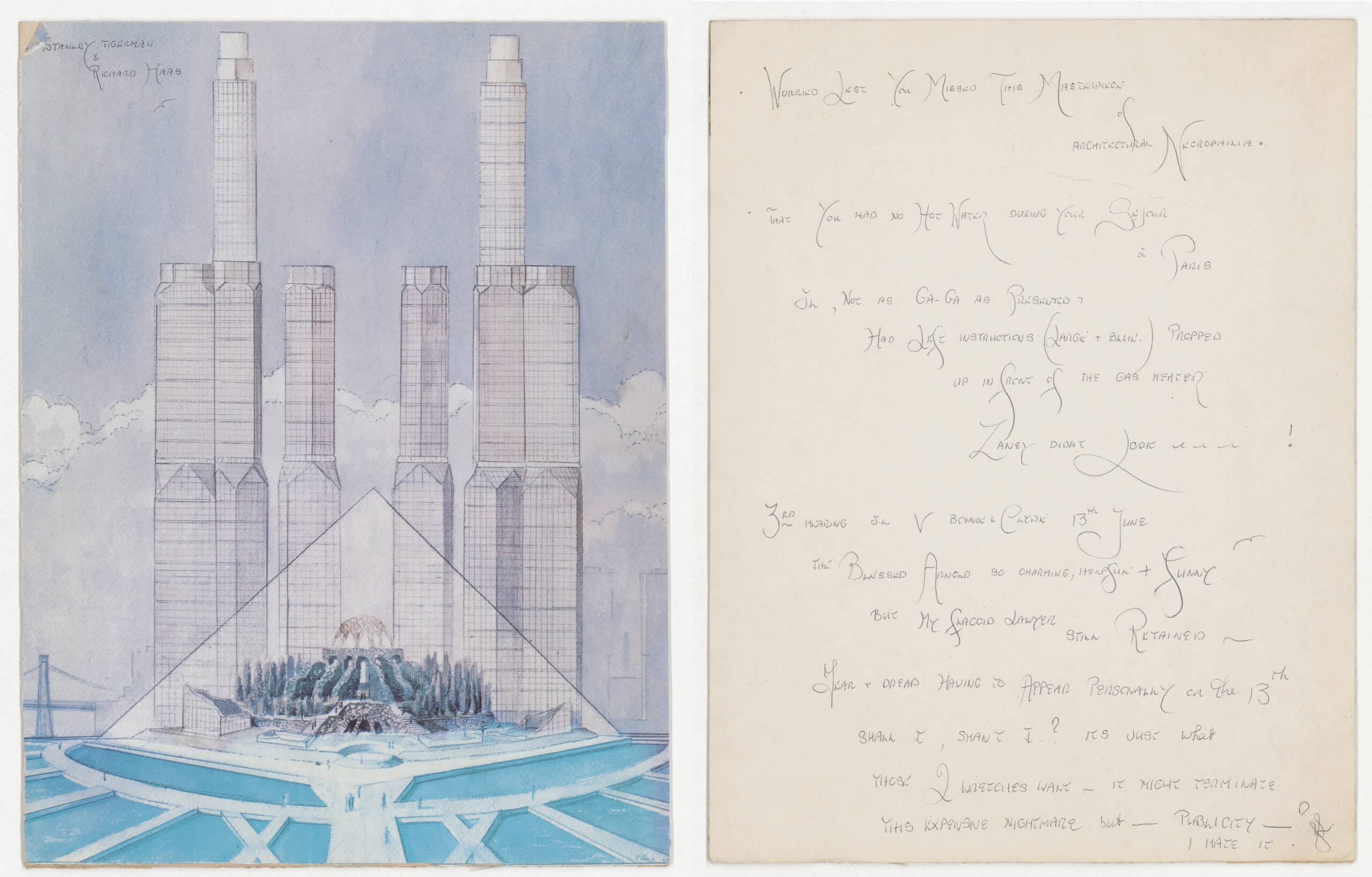
Montages occasionally supplement Littlewood’s commentaries. An oversized image of the soles of feet (of unknown provenance) is pasted onto the bottom right corner of the page over the last characters of a sentence in her notes. The note was presumably to Price to judge from its current location among his personal papers in St. Johns Library, Cambridge. (Figure 4) Recalling how one’s feet lend life to action on stage, Littlewood draws a complete workout for feet exercises – ‘TO BE EFFECTED EACH MORNING – IN A WARM BATH’. [12] The reverse page includes some doodles with suggestions for the buttocks and closes ‘RELAX. DO IT AGAIN TOMORROW MORNING.’ [13]
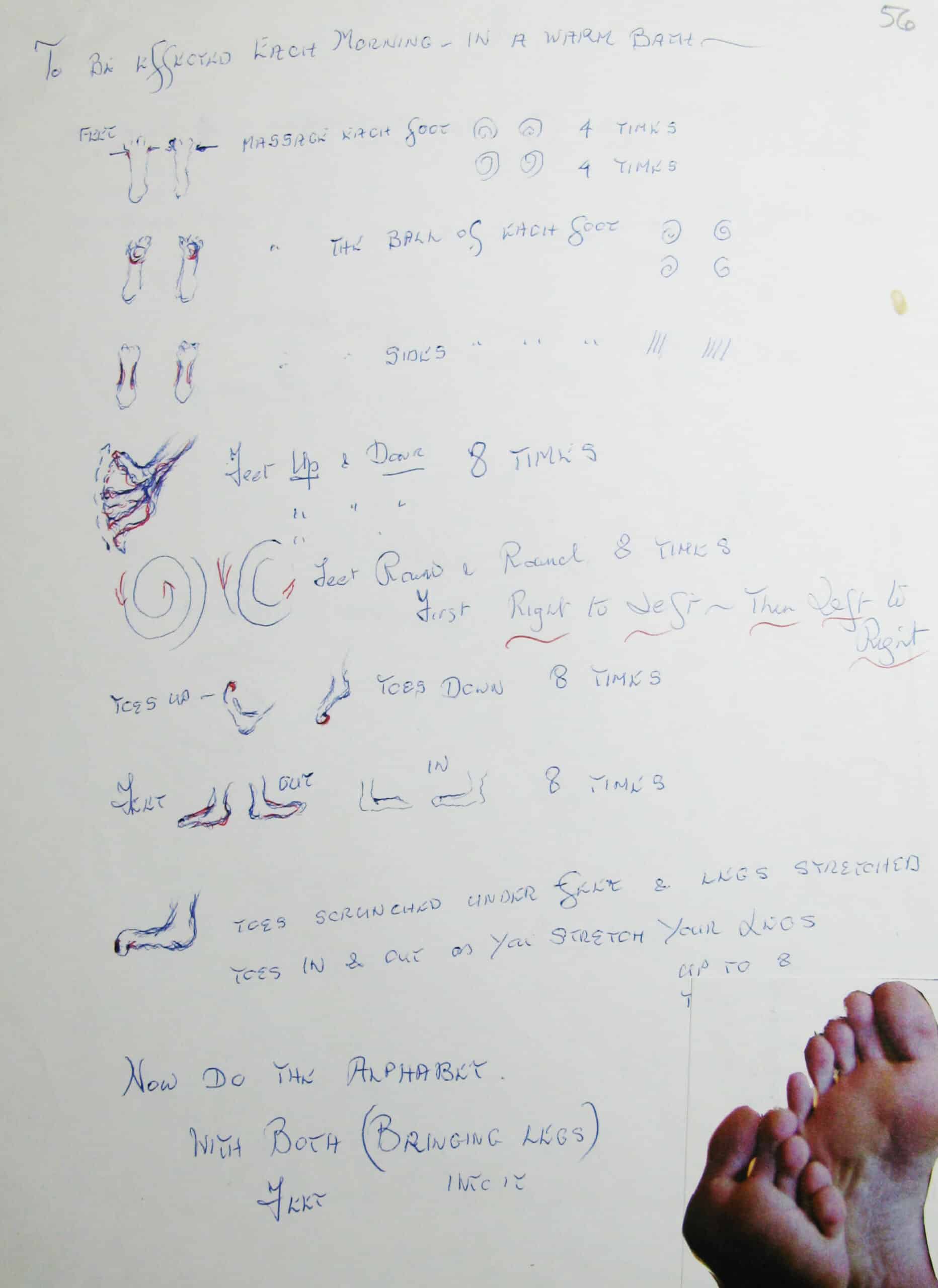
On the cover of another note, a cut-out from the situationist project by Alex Trocchi Sigma Portfolio forms a kind of speech bubble, which encloses the following sentence from the original typed document: ‘International Cultural Enterprises (…) It cannot be repeated too often that sigma “does not exist”’. [14] (Figure 5) ‘*RE TROCHEE’, Littlewood writes within the two lines. And below she elaborates that no communication issues should then follow: ‘NO COM’CAT PROBLEMS THEREFORE. L.‘. [15] Pasted over this blue cut-out is a shorter line in yellow with the keyword ‘ANALYSIS’ in Price’s own handwriting, a title Littlewood chose from the typical carbonless paper sheets his office issued to report any Fun Palace developments. The reverse of the note is addressed to ‘ZEE BREISZ’ (‘C Price’, an onomatopoeic for Price’s whistling ‘s’) [16] at ‘BRASSIERIE. TOP OF THE TOWN.’ [17] (Figure 6) ‘WELL ZEE – !’ opens the note on a headed paper from ‘RAFFIA & MAFFIA’, an agency based in the London Docks. Littlewood’s black and red pen fills the page – ‘Your ref: CITIZENS ADVICE DEPT.’ – to report to Price on her attempts to raise funds for the Fun Palace: [18]
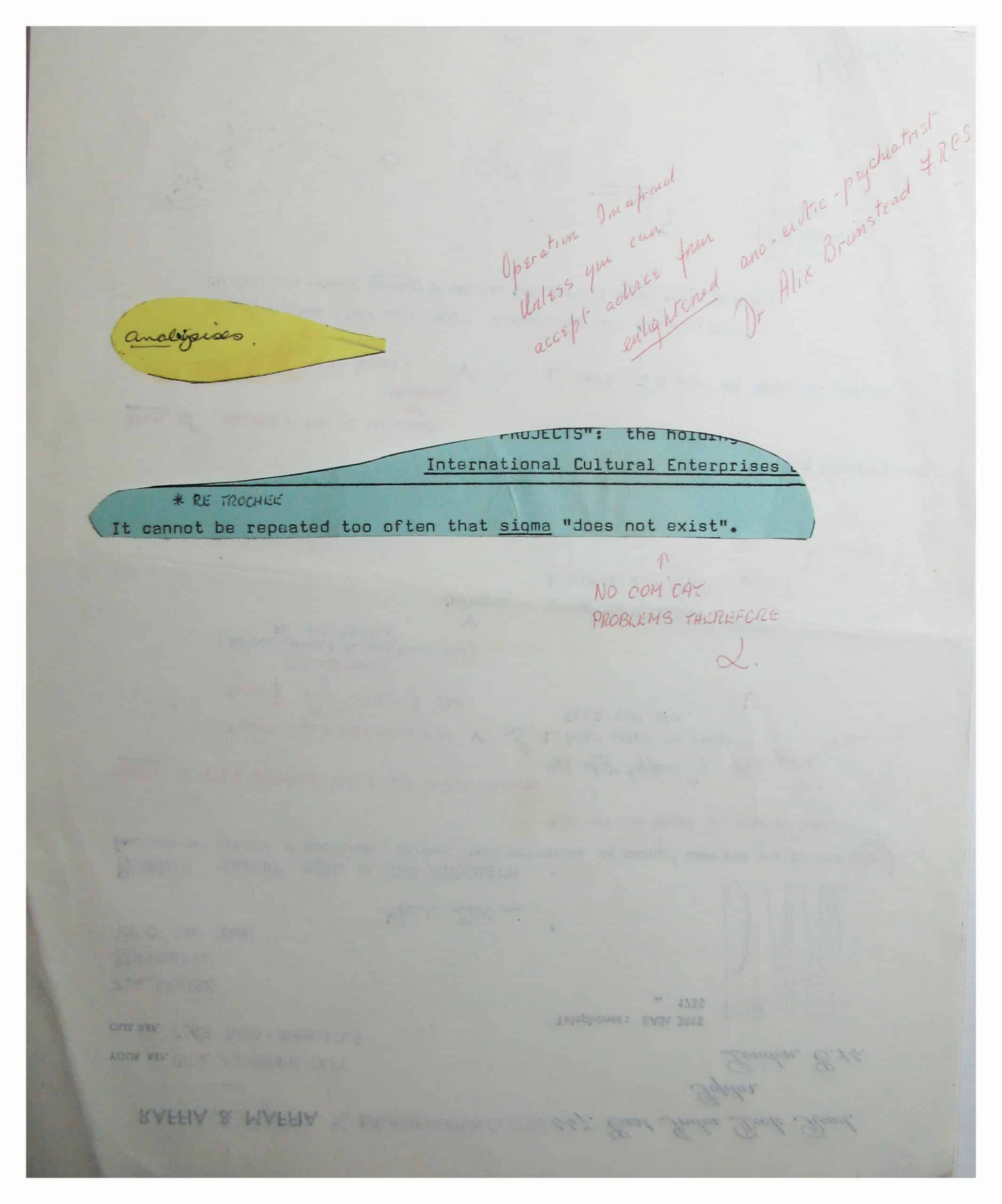

As is often the case, a series of doodles animate the margins and spaces of the note. The celebratory line ‘CHAMPAGNE / BREAKFASTS FOR ALL BIRDS ON THE MENU’ runs next to two sketchy caricatures that could resemble Littlewood and Price, before the closing signature – ‘ISSY. PP. HELL’. [19]
This collection of Littlewood’s notes cannot be overlooked. They carry her voice unmediated as she actively engages in what is most relevant to her, namely, the mastery of humour for the enjoyment of her audience. She often writes ‘IN HASTE’ on any loose sheet of paper at hand and sends it off. One addressee plays multiple roles – ‘LANDLORD’, ‘ARC.A’, ‘PRICE – EX-BIRD SPEC’, ‘ZEE BREISZ’. Capitalised characters march firmly, spaced out to seize the page. In precise control of their gravity, these bodies on stage convey a light-hearted mood and speak the mind that drew them into existence. Here, a large jolly curl celebrates the moment; [20] there, decorative doodles dramatise affects – ‘BOMB’; ‘ACID BATH’; ‘BAD WORDS’– while tight and tilted letters reveal the determination of their author – ‘ISSY P.P HELL’. [21] Pen colour and precise spacing on the page individualise speech in a meeting minute titled ‘HELL VERSION OF ARC’. [22] Littlewood relishes the cuts that distort the communication – ‘COM’CATS’– with her close collaborators. In despair when her interlocutor would lag behind, she says to Price: ‘COULD YOU BUY YOURSELF A GUIDE TO JARGON AS A MEANS OF COMMUNICATION’. [23] Yet she would always turn to him for advice: ‘PLEASE FISH IN YOUR BRAIN TANK AND TELL ME WHO COULD DESIGN AN ASSAULT COURSE FOR MY LITTLE ANGELS.’ [24] Delegates of the clowns she so adored in her theatre, the notes are enigmatic, trivial and trenchant. Their energy comes from their brevity, fuelled by the contraction of language. And their zest lies in their ambiguity, a playful occupation of gestures and spaces. Each of these material artefacts embodies the rhapsodic mood of the Fun Palace production.
How then to approach writing about these notes? How to register in writing the particular trajectories of her calligraphy, or the intensities that size, colour, underlining or punctuation marks added to the text? And how to convey the modes in which its characters occupy the page, those little drawings and doodles that develop in its margins? These questions foreground a feeling that the closer we look at these manuscripts, the further they move away from us. The effects embodied by these ecstatic marks resist becoming flattened in type, and there seem to be no safe translations, only bewilderment. Attempts to transcribe or translate Littlewood’s voice in academic discourse only deactivate it, draining away its effervescent singularity. Rather than dismembering her notes, it may be more productive to preserve their integrity and reflect upon the modes in which they exist, the contexts in which they intervene, and the transformations that they affect. Maybe by asking what they actually do and where they are at any particular time, we can find a way of engaging with them on their own terms.
Unlike the unambiguous accounts crafted to publicise the Fun Palace, Littlewood’s notes are utterly elliptical. Her figures of speech retain an opacity that prevents their swift assimilation by the media. Such a nuanced mode of speech resonates with what Spanish philosopher José Luis Pardo refers to as the intimacy of language. For Pardo intimacy entails a ‘limit condition’, a kind of citadel with respect to the banalization that publicity imposes on contemporary culture. [25] This publicity flattens language into information that then floods both public space and the increasingly privatised time of consumption that defines contemporary life. Publicity and privacy are part of the same process of alienation that narrows down the plurality of society into the discrete image of a market that matches the offer provided by the media. Pardo argues that intimacy, on the other hand, exists as a fold in language. It is encountered as a resonance or affect that conveys meaning tacitly rather than explicitly. In each moan, yell and hesitation, intimacy emanates from the cadences that define human speech. Or, rather, claims Pardo, our humanity lies in our ability to be intimate, nurtured by each of our idiosyncrasies and inclinations, which in turn animate our conversations. The desire to speak arises only out of the precarity that intimacy affords. Connotative and affective, intimate conversations do not communicate anything; rather, argues Pardo, they keep us in touch. And in so doing, intimacy sustains the community that invents its own words and shares them to protect its own space, one within which to grow.
Littlewood’s notes exude the intimacy that Pardo reflects on. Her words speak in a different language to that of publicity. They are not aimed at being informative but instead performative; they are not translatable nor transcribable but affective. Bound in a dialectical relationship to the publicity of the Fun Palace, these fragile and haptic lines draw a blind spot in the project’s public discourse. Over and above all, what these notes seem to do is animate the conversation and keep its flow. Littlewood’s intimate lines lubricate the vitality of each of her productions with a precise mixture of humour and direction. They carve out the tight space within which each action nourishes and renews itself. And in so doing, they also mark the community that creates. One wonders if the Fun Palace production could have been sustained for so long without the continuous movement that these intimate lines encourage and nurture.
An equally pressing question to their agency then is the interrogation of the modes in which these material artefacts live within the sites that preserve them today and the way they affect contemporary readings of the project. Littlewood’s notes are ubiquitous across the Fun Palace archive, or rather, the Fun Palace belongs in the place where her notes emerge, often unexpectedly. These memos punctuate in an undifferentiated way the different collections of Cedric Price’s archive (as conveyed in the captions of the images here) often challenging the classification systems that define each of these sites today. A number of these records continue to resurface today, through the ongoing cataloguing and digitisation of collections bequeathed by public institutions (as in the case of Joan Littlewood’s personal papers at the British Library). Open, fragmentary and dispersed, the collection of Littlewood’s intimate lines gives warmth to the cartography of the Fun Palace’s archive and enlivens it.
Images are reproduced with the kind agreement of Joan Littlewood’s estate.
Notes
- Clive Barker, ‘Closing Joan’s Book: Some Personal Footnotes’, New Theatre Quarterly 19, no. 2 (May 2003), p.103.
- Ibid., p.105.
- ‘British Library acquires archive of Theatre Royal Stratford East and Theatre Workshop’, British Library, 2 February 2021.
- ‘Murray Melvin in conversation with Michael Billington’, National Theatre, YouTube. 8 May 2014, min. 13:37–13:45. Accessed 3 October 2022.
- ‘Oh What a Lovely War: A Tribute to Joan Littlewood’, theatrecloud, YouTube. 9 February 2015, min. 4:33–4:46. Accessed 3 October 2022.
- Michael Arditti, ‘Joan Littlewood: Making a Scene’, Independent Magazine, 26 March 1994. Accessed 3 October 2022
- Cedric Price, ‘JL the View’. DR1995:0188:955. Cedric Price fonds, CCA
- Ibid.
- Ibid.
- ‘Stanley Tigerman & Richard Haas’ memo by Joan Littlewood. Folder DR2004:1430, Cedric Price fonds, CCA.
- Ibid.
- ‘To be effected each morning – in a warm bath’, memo by Joan Littlewood. Joan Littlewood Correspondence, Cedric Price Personal Papers, St. Johns Library Special Collections.
- Ibid.
- ‘Zee Breisz’ memo by Joan Littlewood. Folder Joan Littlewood Correspondence, Cedric Price Personal Papers, St. Johns Library Special Collections.
- Ibid.
- I am grateful to Prof. Mark Dorrian for this observation.
- Ibid.
- Ibid.
- Ibid.
- Cedric Price, ‘JL the View’.
- Cedric Price, ‘Zee Breisz’.
- Cedric Price, ‘Hell Version of Arc’ memo by Joan Littlewood, 1 January 1965. Folder DR1995:0188:525:005, Cedric Price fonds, CCA.
- Cedric Price, ‘In Haste’ memo by Joan Littlewood. DR1995:0188:525:002:002:009, Cedric Price fonds, CCA.
- Cedric Price, ‘Follies de Temps’ memo by Joan Littlewood, 13 May 1974. Folder DR1995:0188:525:005, Cedric Price fonds, CCA.
- José Luis Pardo, La intimidad (Valencia: Pre-Textos, 1996).
